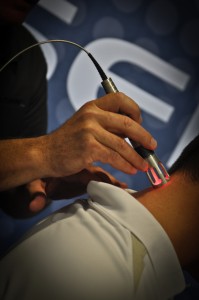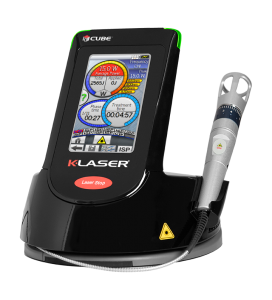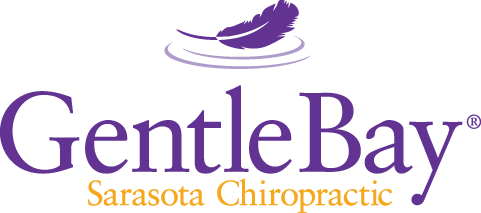Laser therapy with the state-of-the-art K-Laser offers relief where other therapies may fall short. Use of this FDA-cleared treatment is growing rapidly for good reason – laser therapy can give relief from the pain, inflammation and muscle spasm that are involved in a wide variety of conditions.
What is Laser Therapy?
Laser Therapy, or “photobiomodulation”, is the use of specific wavelengths of light (red and near-infrared) to create therapeutic effects. These effects include improved healing time, pain reduction, increased circulation and decreased swelling. Laser Therapy has been widely utilized in Europe by physical therapists, nurses and doctors as far back as the 1970’s. Now, after FDA clearance in 2002, Laser Therapy is being used extensively in the United States.
Laser Therapy can help with the pain, inflammation and muscle spasm of:
Tendinitis ∙ Post-concussion Syndrome ∙ Lateral Epicondylitis (Tennis Elbow) ∙ Repetitive Stress Injuries ∙ Plantar Fascitis ∙ Rheumatoid Arthritis ∙ Osteoarthritis ∙ Shoulder, Back & Knee Pain ∙ Herpes Zoster (Shingles) ∙ Post-Traumatic Injury ∙ Trigeminal Neuralgia ∙ Fibromyalgia ∙ Diabetic Neuropathy ∙ Diabetic Foot Ulcers ∙ Burns ∙ Deep Edema / Congestion ∙ Sports Injuries
Patient Benefits of Laser Therapy
Laser Therapy is proven to biostimulate tissue repair and growth. The Laser decreases inflammation, pain, and scar tissue formation. In the management of chronic pain Class IV Laser Therapy can provide dramatic results, is non-addictive and virtually free of side effects.
Has effectiveness been demonstrated scientifically?
Yes. There are thousands of published studies demonstrating the clinical effectiveness of Laser Therapy. Among these, there are more than one hundred rigorously controlled, scientific studies that document the effectiveness of laser for many clinical conditions.
Cellular Effects of Laser Therapy
During Laser Therapy the infrared laser light interacts with tissues at the cellular level and metabolic activity increases within the cell, improving the transport of nutrients across the cell membrane. This initiates the production of cellular energy (ATP) that leads to a cascade of beneficial effects, increasing cellular function and health.
Laser Therapeutic Effects
During each painless treatment laser energy increases circulation, drawing water, oxygen, and nutrients to the damaged area. This creates an optimal healing environment that reduces inflammation, swelling, muscle spasms, stiffness, and pain. As the injured area returns to normal, function is restored and pain is relieved. Laser therapy also triggers neuro-modulation and bio-modulation, or the normalization of nerve and cell function, which can benefit problems like neuropathy, post-concussion syndrome, fibromyalgia and chronic pain.
K-Laser Advanced Technology
K-Laser leads the way in pain management, tissue repair, safe treatments, and fast treatment times. Our K-Laser offers:
• Four-Wavelength Beam that Penetrates Deep into the Tissue
• Continuous & Modulating Frequencies to Promote Pain Control and Healing.
• SuperPulse Mode for Deeper Therapeutic Penetration
• High Power Delivering Larger Doses, Resulting in Shorter Treatment Times.
Why choose GentleBay Laser Therapy?
• Our clinical experience in knowing where to treat can be crucial. Many times pain in the body is referred, meaning that it is felt in a different place than the irritated tissue. For example, knee pain can be referred from an irritated hip joint. Our assessment techniques help locate the source of pain, so effective treatment can be given. Laser applied to healthy tissue does nothing, but when applied to stressed tissue can give rapid relief.
• The K-Laser is one of the most advanced therapeutic lasers on the market, giving us the most control, before and during treatment, to change treatment settings in a way that is tailored to each patient for the best results.
Frequently Asked Questions
Does it hurt? What does a treatment feel like? There is little or no sensation during treatment. Occasionally one feels mild, soothing warmth or tingling. Areas of pain or inflammation may be sensitive briefly before pain reduction.
Are there any side effects or associated risks? During more than twenty years of use by healthcare providers all over the world, very few side effects have ever been reported. Occasionally some old injuries or pain syndromes may feel aggravated for a few days, as the healing response is more active after treatment.
How long does each treatment take? The typical treatment is 6 to 12 minutes, depending on the size of the area being treated.
How often should a patient be treated? Acute conditions may be treated daily, particularly if they are accompanied by significant pain. More chronic problems respond better when treatments are received 2 to 3 times a week, tapering to once a week or once every other week, with improvement.
How many treatments does it take? This depends on the nature of the condition being treated. For some acute conditions 1 to 6 treatments may be sufficient. Those of a more chronic nature may require 10 to 15 (or more) treatments. Conditions such as severe arthritis may require ongoing periodic care to control pain.
How long before the results are felt? You may feel improvement in your condition (usually pain reduction) after the very first treatment. Sometimes you will not feel improvement for a number of treatments. This does not mean that nothing is happening. Each treatment is cumulative and results are often felt after 3 or 4 sessions.




